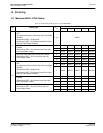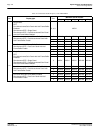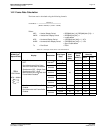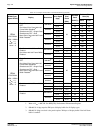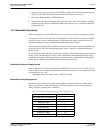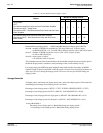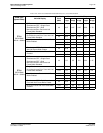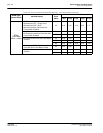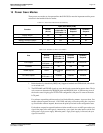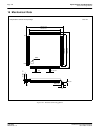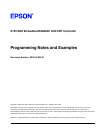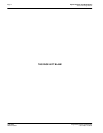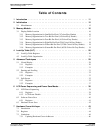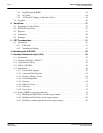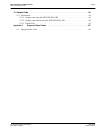
Epson Research and Development
Page 147
Vancouver Design Center
Hardware Functional Specification S1D13505
Issue Date: 01/02/02 X23A-A-001-14
15 Power Save Modes
Three power save modes are incorporated into the S1D13505 to meet the important need for power
reduction in the hand-held device market.
1. Refresh method is selectable by REG[1Ah]. Supported methods are CBR refresh, self-refresh
or no refresh at all.
2. The FPFRAME and FPLINE signals are set to their inactive states during power-down. The in-
active states are determined by REG[07h] bit 6 and REG[0Ch] bit 6. A problem may occur if
the inactive state is high (typical TFT/D-TFD configuration) and power is removed from the
LCD panel.
For software suspend the problem can be solved in the following manner. At power-down, first
enable software suspend, then wait ~120 VNDP, and lastly reverse the polarity bits. At power-
up, first disable software suspend, then revert the polarity bits back to the configuration state.
For hardware suspend an external hardware solution would be to use an AND gate on the sync
signal. One input of the AND gate is connected to a sync signal, the other input would be tied
to the panel’s logic power supply. When the panel’s logic power supply is removed, the sync
signal is forced low.
Table 15-1: Power Save Mode Function Summary
Function
Power Save Mode (PSM)
Normal
(Active)
No Display
LCDEnable = 0
CRTEnable = 0
Software
Suspend
Hardware
Suspend
Display Active? Yes No No No
Register Access Possible? Yes Yes Yes No
Memory Access Possible? Yes Yes No No
LUT Access Possible? Yes Yes Yes No
Table 15-2: Pin States in Power-save Modes
Pins
Pin State
Normal
(Active)
No Display
LCDEnable = 0
CRTEnable = 0
Software
Suspend
Hardware
Suspend
LCD outputs
Active
(LCDEnable = 1)
Forced Low
2
Forced Low
2
Forced Low
2
LCDPWR
On
(LCDEnable = 1)
Off Off Off
DRAM outputs Active
CBR Refresh
only
Refresh Only
1
Refresh Only
1
CRT/DAC outputs
Active
(CRTEnable = 1)
Disabled Disabled Disabled
Host Interface outputs Active Active Active Disabled



